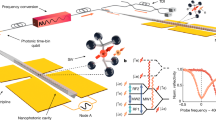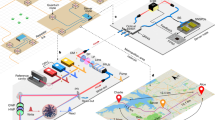Abstract
Many-body open quantum systems balance internal dynamics against decoherence and measurements induced by interactions with an environment1,2. Quantum circuits composed of random unitary gates with interspersed projective measurements represent a minimal model to study the balance between unitary dynamics and measurement processes3,4,5. As the measurement rate is varied, a purification phase transition is predicted to emerge at a critical point akin to a fault-tolerant threshold6. Here we explore this purification transition with random quantum circuits implemented on a trapped-ion quantum computer. We probe the pure phase, where the system is rapidly projected to a pure state conditioned on the measurement outcomes, and the mixed or coding phase, where the initial state becomes partially encoded into a quantum error correcting codespace that keeps the memory of initial conditions for long times6,7. We find experimental evidence of the two phases and show numerically that, with modest system scaling, critical properties of the transition emerge.
This is a preview of subscription content, access via your institution
Access options
Access Nature and 54 other Nature Portfolio journals
Get Nature+, our best-value online-access subscription
$29.99 / 30 days
cancel any time
Subscribe to this journal
Receive 12 print issues and online access
$209.00 per year
only $17.42 per issue
Buy this article
- Purchase on Springer Link
- Instant access to full article PDF
Prices may be subject to local taxes which are calculated during checkout



Similar content being viewed by others
Data availability
All data is available in the manuscript or the Supplementary Information.
References
Carmichael, H. An Open Systems Approach to Quantum Optics (Springer, 1993).
Gardiner, C. W. & Zoller, P. Quantum Noise (Springer, 2000).
Skinner, B., Ruhman, J. & Nahum, A. Measurement-induced phase transitions in the dynamics of entanglement. Phys. Rev. X 9, 031009 (2019).
Li, Y., Chen, X. & Fisher, M. P. A. Quantum Zeno effect and the many-body entanglement transition. Phys. Rev. B 98, 205136 (2018).
Li, Y., Chen, X. & Fisher, M. P. A. Measurement-driven entanglement transition in hybrid quantum circuits. Phys. Rev. B 100, 134306 (2019).
Gullans, M. J. & Huse, D. A. Dynamical purification phase transition induced by quantum measurements. Phys. Rev. X 10, 041020 (2020).
Choi, S., Bao, Y., Qi, X.-L. & Altman, E. Quantum error correction in scrambling dynamics and measurement-induced phase transition. Phys. Rev. Lett. 125, 030505 (2020).
Jian, C.-M., You, Y.-Z., Vasseur, R. & Ludwig, A. W. W. Measurement-induced criticality in random quantum circuits. Phys. Rev. B 101, 104302 (2020).
Bao, Y., Choi, S. & Altman, E. Theory of the phase transition in random unitary circuits with measurements. Phys. Rev. B 101, 104301 (2020).
Aharonov, D. Quantum to classical phase transition in noisy quantum computers. Phys. Rev. A 62, 062311 (2000).
Gottesman, D. An introduction to quantum error correction and fault-tolerant quantum computation. Quant. Info. Sci. Contr. Math., Proc. Symp. App. Math. 68, pp.13–58 (Amer. Math. Soc., Providence, Rhode Island, 2010).
Gullans, M. J. & Huse, D. A. Scalable probes of measurement-induced criticality. Phys. Rev. Lett. 125, 070606 (2020).
Brydges, T. et al. Probing Rényi entanglement entropy via randomized measurements. Science 364, 260–263 (2019).
Schrödinger, E. Probability relations between separated systems. Math. Proc. Camb. Philos. Soc. 32, 446–452 (1936).
Wineland, D. J. Nobel lecture: Superposition, entanglement and raising Schrödinger’s cat. Rev. Mod. Phys. 85, 1103–1114 (2013).
Haroche, S. Nobel lecture: Controlling photons in a box and exploring the quantum to classical boundary. Rev. Mod. Phys. 85, 1083–1102 (2013).
Minev, Z. K. et al. To catch and reverse a quantum jump mid-flight. Nature 570, 200–204 (2019).
Barreiro, J. T. et al. An open-system quantum simulator with trapped ions. Nature 470, 486–491 (2011).
Yang, D., Grankin, A., Sieberer, L. M., Vasilyev, D. V. & Zoller, P. Quantum non-demolition measurement of a many-body Hamiltonian. Nat. Commun. 11, 775 (2020).
Vitale, V. et al. Symmetry-resolved dynamical purification in synthetic quantum matter. SciPost Phys. 12, 106 (2022).
Maunz, P. L. W. High optical access trap 2.0. Report No. SAND2016-0796R (Sandia National Laboratories, 2016); http://prod.sandia.gov/techlib/access-control.cgi/2016/160796r.pdf
Egan, L. et al. Fault-tolerant control of an error-corrected qubit. Nature 598, 281–286 (2021).
Foss-Feig, M. et al. Entanglement from tensor networks on a trapped-ion QCCD quantum computer. Phys. Rev. Lett. 128, 150504 (2022).
Gottesman, D. The Heisenberg representation of quantum computers. In Proc. XXII International Colloquium on Group Theoretical Methods in Physics 32–43 (International Press, 1998); https://arxiv.org/abs/quant-ph/9807006
Aaronson, S. & Gottesman, D. Improved simulation of stabilizer circuits. Phys. Rev. A 70, 052328 (2004).
Ippoliti, M., Gullans, M. J., Gopalakrishnan, S., Huse, D. A. & Khemani, V. Entanglement phase transitions in measurement-only dynamics. Phys. Rev. X 11, 011030 (2021).
Cetina, M. et al. Control of transverse motion for quantum gates on individually addressed atomic qubits. PRX Quantum 3, 010334 (2022).
Lavasani, A., Alavirad, Y. & Barkeshli, M. Measurement-induced topological entanglement transitions in symmetric random quantum circuits. Nat. Phys. 17, 342–347 (2021).
Sang, S. & Hsieh, T. H. Measurement-protected quantum phases. Phys. Rev. Res. 3, 023200 (2021).
Napp, J., La Placa, R. L., Dalzell, A. M., Brandao, F. G. S. L. & Harrow, A. W. Efficient classical simulation of random shallow 2D quantum circuits. Phys. Rev. X 12, 021021 (2022).
Gullans, M. J., Krastanov, S., Huse, D. A., Jiang, L. & Flammia, S. T. Quantum coding with low-depth random circuits. Phys. Rev. X 11, 031066 (2021).
Maslov, D. Basic circuit compilation techniques for an ion-trap quantum machine. N. J. Phys. 19, 023035 (2017).
Acknowledgements
We acknowledge fruitful discussions with E. Altman, S. Choi, A. Deshpande, S. Diehl, B. Fefferman, S. Gopalakrishnan, M. Ippoliti, V. Khemani, A. Nahum, J. Pixley, O. Shtanko and A. Zabalo, and the contributions of M. Goldman, K. Beck, J. Amini, K. Hudek and J. Mizrahi to the experimental set-up. This work is supported by the ARO through the IARPA LogiQ programme, the NSF STAQ programme, the AFOSR MURIs on Dissipation Engineering in Open Quantum Systems and Quantum Measurement/Verification and Quantum Interactive Protocols, the ARO MURI on Modular Quantum Circuits, the DoE Quantum Systems Accelerator, the DoE ASCR Accelerated Research in Quantum Computing programme (award no. DE-SC0020312) and the National Science Foundation (QLCI grant no. OMA-2120757). L.E. is also funded by NSF award no. DMR-1747426. This work was performed at the University of Maryland with no material support from IonQ.
Author information
Authors and Affiliations
Contributions
C.N. collected the data. C.N. and P.N analysed the data. C.N., P.N. and M.J.G. wrote the manuscript and designed figures. M.C. and C.M. led construction of the experimental apparatus with contributions from C.N., D.Z., A.R., L.E. and D.B. Theory support was provided by P.N., M.J.G., A.V.G. and D.A.H. C.M., M.J.G. and D.A.H. supervised the project. All authors discussed the results and contributed to the manuscript.
Corresponding author
Ethics declarations
Competing interests
The authors declare no competing interests.
Peer review
Peer review information
Nature Physics thanks Yi-Zhuang You and Tobias Schaetz for their contribution to the peer review of this work.
Additional information
Publisher’s note Springer Nature remains neutral with regard to jurisdictional claims in published maps and institutional affiliations.
Extended data
Extended Data Fig. 1 Scrambling Unitary.
Example of a scrambling unitary on a system with L = 6 qubits. Each single-qubit gate C refers to a random single-qubit Clifford gate. The XX gates have an implied rotation angle of π/4.
Extended Data Fig. 2 Feedback Truth Table.
Truth table for outcomes of measurement ancillae and reference qubit for a circuit.
Extended Data Fig. 3 Feedback Circuit.
Feedback circuit corresponding to example circuit #45 described in Methods.
Extended Data Fig. 4 Histogram of Experimental Data for S_C.
All raw outcomes of SC in study of phases (main text Fig. 3a). The legend indicates the simulated expected outcome for that circuit. The bin size is .033 and SC = . 93 (dashed line) is used as a threshold for all the data.
Extended Data Fig. 5 Comparison of Theory and Experiment.
(a) Raw average of all circuit outcomes without thresholding applied. (b) Thresholded data with extended simulations showing expected behaviour up to L=32.
Extended Data Fig. 6 Analysis Method to Extract Critical Data.
(a) Late time decay of 〈SQ〉 showing the exponential decay regime used to extract the decay rate τ. Here, we took (P, Px) = (0.15, 0.7) near the critical point. (b) Scaling of τ vs L for different values of Px at P = 0.15. We can estimate Pxc and extract z by looking for the inflection point in this family of curves and fitting the slope.
Supplementary information
Supplementary Information
Supplementary Discussion and Supplementary Figs. 1 and 2.
Rights and permissions
About this article
Cite this article
Noel, C., Niroula, P., Zhu, D. et al. Measurement-induced quantum phases realized in a trapped-ion quantum computer. Nat. Phys. 18, 760–764 (2022). https://doi.org/10.1038/s41567-022-01619-7
Received:
Accepted:
Published:
Issue Date:
DOI: https://doi.org/10.1038/s41567-022-01619-7
This article is cited by
-
Multi-site integrated optical addressing of trapped ions
Nature Communications (2024)
-
Quantum many-body simulations on digital quantum computers: State-of-the-art and future challenges
Nature Communications (2024)
-
Statics and dynamics of non-Hermitian many-body localization
Communications Physics (2024)
-
Random-Matrix Models of Monitored Quantum Circuits
Journal of Statistical Physics (2024)
-
Measurement-induced entanglement phase transition on a superconducting quantum processor with mid-circuit readout
Nature Physics (2023)



